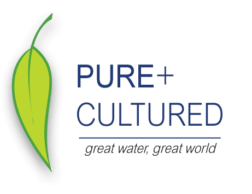We were recently contacted to quote a full Pure+Cultured solution (including MicroPure – Cafe, Peristaltic Pump and auto-dosaging) for a chain of restaurants in Brisbane. There’s actually so much background information surrounding the quote that we thought it advantageous to share it in a short blog (minus any identifying features of course!) It’s a little copy-and-paste, so please bare with it. HAHA.
Excerpts from our response:
The product that we recommend for commercial grease traps is a liquid consisting of microbes and nutrients. We call this MicroPure – Cafe. This particular blend of microbes has been cultivated to eat organic waste, in particular fats, oils and grease. When introduced into the ideal environment these microbes will eat the organic waste and multiple in number. They are adversely affected by heat, such as hot water, and chemicals.
Application of our product is by pouring the prescribed dosage of liquid into the kitchen sink daily. This is usually done at the end of the working day so the microbes can sit in the waste water system and grease trap without any additional hot water entering the system for as long as possible. Daily application is recommended as this will replenish the number of productive microbes into the system.
The main objective of using our product in commercial grease traps is to clean the grease trap, however many of our customers are more focused on reducing their operating costs as the primary objective.
Reduced operating costs
Grease traps in commercial kitchens usually have their grease traps evacuated every 3 to 4 weeks depending on the kitchen volumes, the size of the grease trap and the type of waste being generated through the food preparation process. Urban Utilities, who set the rules around grease trap safety in Queensland allow a 13-week cycle between grease trap evacuations. Unfortunately for the owners and the environment most grease traps can’t go that long between evacuations.
By extending the evacuation cycle to 13 weeks it reduces the evacuation costs by around 23% to 30% of the current expense. Allowing for the cost of our product the overall cost will still be only 55% of their current annual evacuation spend.
The environment
The environment is the big winner in this solution. Currently the fats and grease being collected through grease trap evacuations is being transported to landfill waste sites to be recycled or left to degenerate over time. It is a very simple equation. Extend evacuation times from 3 weeks to 12 weeks and only 25% of the current oils and fats will end up in landfill sites.
I have estimated that there are over 50,000 grease traps in Australia. With an evacuation cycle of 3 weeks they are currently evacuating and transporting 1.8 billion litres of waste material every year. This could be reduced to 450 million litres per year. To provide some perspective of this quantity, Wivenhoe Dam, just west of Brisbane holds 1.1 billion litres of water. At current rates this oil and fat being evacuated could fill Wivenhoe Dam every 7.6 months.
A report commissioned by The Department of Sustainability, Environment, Water, Population and Communities in 2012 confirmed that 1.9 billion tonnes of food organic waste is being delivered to landfill sites each year with only 22.0% of this waste being recycled. This is the highest volume of landfill material with the lowest recycling rate of all materials. The second largest volume of landfill is cardboard at 803 million tonnes per year with a recycling rate of 70.0%.
Another environmental consequence of organic waste material in landfill is the amount of methane gas being generated which in turn increases our greenhouse gas emissions. In fact methane gas accounts for 2.0% of the total emissions in Australia. Australia has targeted to reduce emissions by 5.0% by 2020. This target has been met and we are on track to reduce emissions by 13.0% by 2020. If it was possible to eliminate methane gas from landfill sites this could reduce emissions by an additional 2.0%.
The subtle and possibly more destructive impact of dumping fats and oils at landfill sites is the impact of leaching. This is caused by the toxic liquids from these sites seeping into the natural water system. This disrupts the quality of our water supply.
With our microbe based product it is possible to extend the evacuation cycle to every 26 weeks. This currently requires special approval by Urban Utilities but it is possible.
While speaking in such large terms is a great way to grab someone’s attention, but we must bring the equation back down to you and your restaurants. Any solution we propose must be economically viable and environmentally sustainable. And that is what we have produced in our detailed quote package. We hope that like us, you see the larger flow-on impacts of responsible waste management and encourage further discussions to pin point a solution for your needs.

